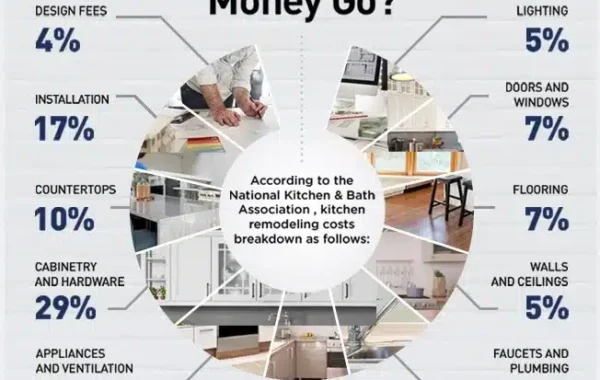How to Choose the Right Flooring for Your Chicago Home
Chicago homes, with their unique blend of architectural styles and the city’s distinct climate, demand careful consideration when selecting flooring. What works beautifully in a sun-drenched California bungalow might be entirely unsuitable for a vintage greystone facing a Windy City winter. This guide navigates the complexities, helping you choose the perfect flooring that balances aesthetics, durability, and comfort.
Understanding Chicago’s Flooring Challenges
Before diving into material options, let’s acknowledge the specific challenges Chicago homes present:
- Temperature Fluctuations: Harsh winters and humid summers can wreak havoc on certain materials, causing expansion, contraction, and even cracking.
- Moisture: Snow, rain, and the potential for basement flooding all contribute to moisture concerns.
- Foot Traffic: High-density living means more wear and tear, especially in entryways and hallways.
- Architectural Style: From classic bungalows to modern condos, the flooring should complement the home’s character.
Considering these factors upfront will prevent costly mistakes and ensure long-term satisfaction.
A Deep Dive into Flooring Options: Pros & Cons for Chicago
Hardwood: Timeless Elegance with Considerations
Pros: Classic aesthetic, adds value, long-lasting (especially with proper care), can be refinished, versatile styles and finishes.
Cons: Susceptible to moisture damage, can scratch easily, requires regular maintenance, can be noisy, may not be ideal for basements.
Chicago Considerations: Opt for harder wood species like oak, maple, or hickory. Engineered hardwood offers greater stability against moisture and temperature changes than solid hardwood. Always ensure proper sealing and humidity control.
Laminate: Budget-Friendly & Durable
Pros: Affordable, water-resistant, scratch-resistant, easy to install, wide variety of styles mimicking wood or tile.
Cons: Can look less authentic than hardwood, difficult to repair, shorter lifespan than hardwood, can be noisy.
Chicago Considerations: A good choice for basements, kitchens, and high-traffic areas. Look for thicker planks (12mm+) for better durability and sound absorption. Select a laminate with a high AC (Abrasion Class) rating for increased wear resistance.
Tile: Versatility & Resilience
Pros: Extremely durable, water-resistant, easy to clean, ideal for bathrooms and kitchens, wide range of styles and prices.
Cons: Can be cold underfoot, hard surface (less comfortable), can be slippery when wet, difficult to install DIY.
Chicago Considerations: Porcelain tile is more water-resistant and durable than ceramic tile, making it a better choice for moisture-prone areas. Consider installing radiant heating beneath tile floors for added comfort during Chicago winters. Select textured or slip-resistant tiles for bathrooms and entryways.
Vinyl: Comfort & Affordability
Pros: Waterproof, comfortable underfoot, quiet, easy to install, available in sheet, tile, and plank formats, wide range of styles.
Cons: Can be susceptible to dents and tears, lower resale value than hardwood or tile, some cheaper vinyls can off-gas VOCs.
Chicago Considerations: Luxury Vinyl Plank (LVP) is a popular choice due to its durability, realistic wood or tile appearance, and water resistance. Ideal for basements, kitchens, and bathrooms. Choose a thicker vinyl with a wear layer of 20 mil or higher for better performance in high-traffic areas.
Carpet: Warmth & Comfort
Pros: Soft and comfortable underfoot, provides warmth, reduces noise, wide range of colors and textures.
Cons: Can stain easily, requires regular cleaning, not ideal for allergy sufferers, can trap moisture.
Chicago Considerations: Best suited for bedrooms and living rooms. Choose stain-resistant and moisture-resistant fibers like nylon or olefin. Consider installing a high-quality padding for added comfort and insulation. Regular professional cleaning is essential to maintain its appearance and prevent mold growth.
Matching Flooring to Your Chicago Home’s Style
The flooring you choose should complement the architectural style and overall aesthetic of your home. Here are some general guidelines:
- Chicago Bungalow: Hardwood floors (oak or maple) with a warm stain, or classic linoleum patterns.
- Greystone: Dark hardwood floors (walnut or ebony stain), or elegant tile in entryways and bathrooms.
- Vintage Apartment: Reclaimed hardwood floors, classic tile patterns, or durable laminate that mimics wood.
- Modern Condo: Sleek concrete floors, large-format tile, or light-colored hardwood floors.
Budgeting for Your Chicago Flooring Project
Flooring costs vary significantly depending on the material, installation complexity, and square footage of the area. Here’s a general breakdown:
- Laminate: $2-$5 per square foot (materials only)
- Vinyl: $3-$7 per square foot (materials only)
- Tile: $5-$15+ per square foot (materials only)
- Hardwood: $8-$20+ per square foot (materials only)
- Carpet: $3-$10+ per square foot (materials only)
Remember to factor in the cost of installation, underlayment, and any necessary subfloor repairs. Getting multiple quotes from reputable flooring contractors is crucial for accurate budgeting. Don’t be afraid to ask for a detailed breakdown of costs to understand where your money is going. A common oversight we’ve seen is failing to adequately budget for subfloor preparation, which can significantly impact the final cost and quality of the installation. For example, neglecting to level an uneven subfloor before installing hardwood can lead to squeaking and warping issues down the line, requiring costly repairs.
The Expert’s Corner: Addressing Moisture Concerns
One of the most common challenges Chicago homeowners face is moisture management. Here are some expert tips:
- Basement Flooring: Avoid carpet and solid hardwood. Opt for waterproof options like LVP, tile, or epoxy coatings.
- Bathroom Flooring: Ensure proper ventilation to prevent moisture buildup. Seal grout lines regularly to prevent water damage.
- Entryway Flooring: Use durable mats to trap dirt and moisture before they reach your flooring. Consider installing a waterproof entryway flooring like tile or LVP.
“Proper subfloor preparation and moisture barriers are essential for ensuring the longevity of your flooring, especially in a climate like Chicago’s,” advises seasoned remodeling contractor, Mark Johnson. “Don’t skimp on these critical steps.”
Conclusion: Your Chicago Flooring Journey
Choosing the right flooring for your Chicago home is a significant investment that can enhance its beauty, comfort, and value. By carefully considering the city’s unique climate challenges, your home’s architectural style, and your budget, you can make an informed decision that you’ll enjoy for years to come. Armed with this knowledge, you’re now better equipped to discuss your vision and requirements with a flooring professional. Why not start gathering samples and exploring different styles to find the perfect fit for your Chicago home?


